Features
ARTRA Magazine features the ’43 Group

The latest issue of ARTRA, celebrating its tenth anniversary, has more illustrations than text: wonderful reproductions of our artists ranging from the naturalistic to cubist, to abstract, interspersed with cartoons; all from the Sapumal Foundation. A double page notes significant dates of the local art world: 1930 and ’36 –
 exhibitions in Colombo of George Keyt and Justin Daraniyagala; 1943 – formation of the ’43 Group on August 29, at Alborada, Guildford Crescent, Colombo 7; 1952 – first overseas exhibition of ’43 Group at the Imperial Institute, London; 1953 – exhibition at the Petit Palas, Paris; 1954 – exhibition at the Heffer Gallery , Cambridge; 1974 – Formation of the Sapumal Foundation by Harry Pieris, Founder Member and only Hon Secy of the ’43 Group. Two deaths are noted: 1944 – Lionel Wendt and 2016 – Richard Gabriel, last death of a core member.
exhibitions in Colombo of George Keyt and Justin Daraniyagala; 1943 – formation of the ’43 Group on August 29, at Alborada, Guildford Crescent, Colombo 7; 1952 – first overseas exhibition of ’43 Group at the Imperial Institute, London; 1953 – exhibition at the Petit Palas, Paris; 1954 – exhibition at the Heffer Gallery , Cambridge; 1974 – Formation of the Sapumal Foundation by Harry Pieris, Founder Member and only Hon Secy of the ’43 Group. Two deaths are noted: 1944 – Lionel Wendt and 2016 – Richard Gabriel, last death of a core member.
Text material consists of Beyond a Revolt & Basked in the Instinctual by Azara Jaleel in three parts: Career developments in the early 1900s, Historical overview of Sri Lankan art and About the artists and their artistic styles. Excerpts from interviews include Cresside Collete (daughter of Aubrey) writing about her Father Figure; Kemal de Soysa titling his short piece True to a fault; T Shanthanan – Timeless cosmopolitans; Michael Anthonisz – Provenance and its importance; Rita Manella – Rekindling Sri Lanka’s rapture; and Rohan de Soya – Art & living / the beauty herein.
Azara Jaleel begins her Editorial thus: “The ’43 Group may be bygone, but the seeds they sowed of new thought and form shaped the beginnings of Sri Lanka’s Modern & Contemporary Art. Thus we take great pride in publishing this important edition in celebration of ARTRA Magazine’s decennium, paying homage to this historic movement.”
The ’43 Group
It was the first 20th century modern art school established in Colombo in 1943. The Group was an association of like–minded artists who had originally been in the Ceylon Society of Arts. The breaking away and formation of a new collective was initiated by Lionel Wendt and had nine artists as key members: Geoffrey Beling (1907-1992), George Claessen (1909-1999), Aubrey Collette , Justin Daraniyagala (1903-1967), Richard Gabriel (1924-2016), George Keyt (1901 1993), Ivan Peries (1924-88), Harry Pieris (1904-88), and Manjusri Thera (1902-1982). They drew influence from Charles Freegrove Winzer who had been Keyt’s and Beling’s teacher. Referencing the name I retrieved the following info. Winzer (1886-1940) was a British painter and lithographer who lived in Paris and was held prisoner in Germany during WWI. He returned to Vienna, then held the post of Chief Inspector of Art in Ceylon and was widely regarded as a leading light in modern art to Ceylonese artists.
The reference adds: “The painting of the Group constituted a historic break in Sri Lankan and more generally, South Asian tradition. The most significant achievement of the ’43 Group is accepted to be their localization of European modernist trends to a distinctively Sri Lankan modernist art.” The Group extended its patronage to films (Lester James Peiris became an associate) and Kandyan and other local dance forms.
Some of the Group
All Sri Lankans know of and about George Keyt and Lionel Wendt. I was familiar with the names of others and knew a few details of each of them, but read up and feel it apt to pass on information gathered on the members who particularly interested me.
Lionel George Henricus Wendt
was pianist, photographer, filmmaker and critic. It was he who was the leader of the ’43 Group and gave it a home, which later was developed to the Lionel Wendt Art Centre with its theatre, exhibition hall and club. His collection of over 400 photographs is the nucleus of his vast art legacy to the country. It was a tragedy and great loss to the country and art that he died at age 44.
Geoffrey Beling.
We in our Kandy school had heard of him as visits by him as Inspector of Art were threatened in my time in the primary school. One sister was praised by him and I think he particularly praised Nalini Wijenaike, mother of Senaka Senanayaka.
Beling was born in Gampola in 1907 to watercolorist father and music teacher mother. In 1926 he went to India to study architecture and art at Bombay’s Sir Jamsetjee Jeejebbhoy School of Art. Two years later he returned due to his father’s death and opened a private art school in Havelock Town and also started exhibiting his work at the Art Club arranged by Charles Freegrove Winzer. Critics considered his art ‘ridiculous and degrading’ but Pablo Neruda, who lived some years in Colombo, thought he was a true artist, rare in Ceylon, and one of the two best. He painted mainly landscapes, still life and portraits.
In 1932, Beling succeeded Winzer as Chief Inspector of Art. and held the post till 1967. Unfortunately he stopped painting around 1945. He married Edith Deutrom and they had four children. One significant fact is that he prepared the original designs of the Lionel Wendt Memorial Arts complex on Guildford Crescent, Colombo 7.
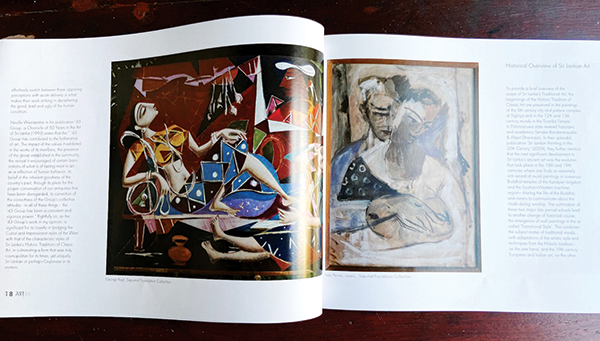
George Claessen
was both artist and poet. His art was characterized by his mystical beliefs and ideas. Born in Colombo in 1909, he was largely a self-taught artist and began painting professionally when, aged 29, he joined the Colombo Port Commission as a draughtsman. He favoured modern European artistic forms over traditional Sri Lankan art. He had a painting displayed in the London National Gallery acquired during WW II by the War Artists’ Advisory Committee. Moving to abstract art, he exhibited his work in many galleries, among them in Melbourne in 1947, in London many times with the Royal Society of British Artists and the Society of Graphic Art and in the Venice Biennale in 1956. Throughout his life he continued working at the Colombo Port Commission and in addition to art, published several volumes of poetry.
L Thomas Peiris Manjusri is to me the most intriguing of founders of the ’43 Group because of the vast changes, even adventures, he made for himself. Born in near poverty in a fishing village in Aluthgama in 1902, he died in 1982, a celebrated, world known Sri Lankan. “His story is a commentary on the cultural history of 20th century Ceylon/ Sri Lanka.”
Manjusri ran away from school and home when 11 years old with the said intention of discovering the world. He first apprenticed himself to a carpenter, then was assistant to a ballad singer uncle. Maybe he travelled around as ballad singers provided entertainment to villages with their viridu singing accompanied by hand held rabana and tambourine. He then became a shop assistant in Beruwela.
He joined the Sangha when 13 and under reputed scholar monks in the Mangala Pirivena, Beruwela; studied Buddhist philosophy along with Sinhala Literature, Sanskrit, Pali and Bengali. In 1932 he joined Rabindranath Tagore’s Santineketan Ashram.
However, had to return in two years when his father died. Thus began his life’s work of systematically copying, tracing and documenting drawings and friezes of old Buddhist temples. Living often in Colombo, he inspired the association of young artists. Thus his being a founder member of the ’43 Group. He visited Vienna and London during this period.
In 1950 aged 48, he disrobed and gave full attention to art and writing on art in South and SE Asia. Married late in life, with the help of wife Mangala, he researched and published in 1975 Design Elements from Sri Lankan Temple Paintings. Many were the awards he won, plaudits and honours for his art, preservation of ancient and medieval Lankan art and his writing. The highest of these was the 1979 Ramon Magsaysay Award for Journalism. ATRA Magazine has done Sri Lanka and the entire art world a favour by showing the disparate works of these artists in one issue in which we can see the diversity of their work and depth of talent. It is obvious that they did not copy from each other, but inspired each other to develop their individual identity and style.
Features
Driving high-tech exports: The pivotal role of R&D

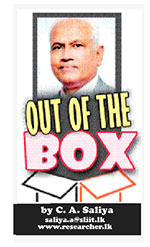 High-tech exports serve as a critical driver of economic growth and global competitiveness for nations. In an era marked by rapid technological advancements and globalization, the ability of a country to expand its high-tech exports hinges significantly on its investment in research and development (R&D). By fostering innovation, enhancing product quality, and improving production efficiency, R&D plays a pivotal role in determining a country’s success in the high-tech export sector. This essay explores the significance of R&D in driving high-tech exports, highlighting its impact on product innovation, international competitiveness, and economic sustainability. Figure 1 compares High-Tech Exports among India, Malaysia and Sri Lanka. (See Graph 01)
High-tech exports serve as a critical driver of economic growth and global competitiveness for nations. In an era marked by rapid technological advancements and globalization, the ability of a country to expand its high-tech exports hinges significantly on its investment in research and development (R&D). By fostering innovation, enhancing product quality, and improving production efficiency, R&D plays a pivotal role in determining a country’s success in the high-tech export sector. This essay explores the significance of R&D in driving high-tech exports, highlighting its impact on product innovation, international competitiveness, and economic sustainability. Figure 1 compares High-Tech Exports among India, Malaysia and Sri Lanka. (See Graph 01)
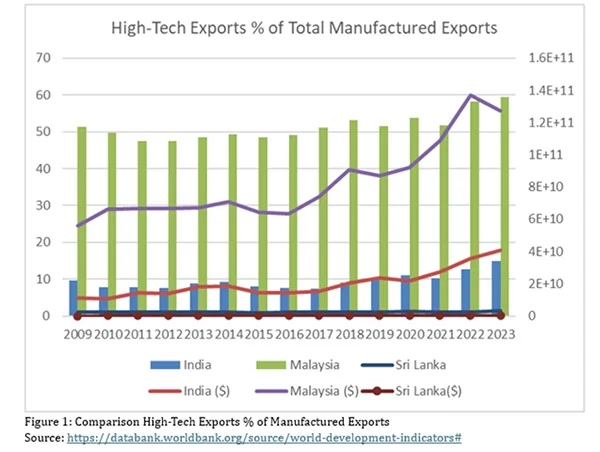
The Link Between R&D and High-Tech Exports
R&D is the backbone of high-tech industries, enabling firms to develop cutting-edge products and services that cater to evolving global market demands. Technological innovations, resulting from R&D investments, enhance the quality, efficiency, and uniqueness of products, making them more attractive to international buyers. Countries with robust R&D ecosystems, such as the United States, Germany, and South Korea, have consistently led the world in high-tech exports. Their ability to create and commercialize innovative technologies underscores the direct correlation between R&D spending and export growth in the high-tech sector. Figure 2 compares High-Tech Exports and Research and Development expenses among India, Malaysia and Sri Lanka. (See Graph 2)
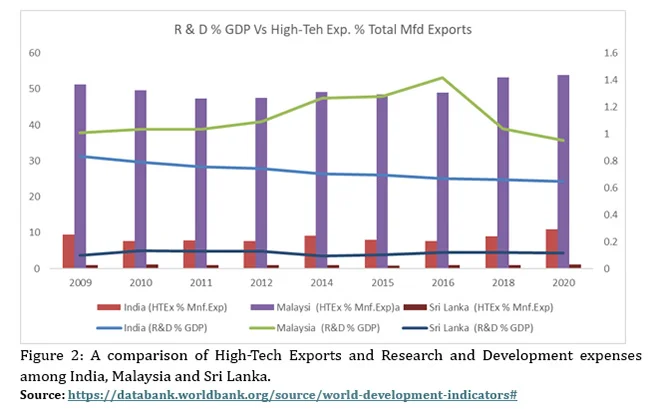
Figure 3 shows a comparison of High-Tech Exports and Research and Development expenses of Sri Lanka with Germany, Malaysia and the US. (See Graph 03)
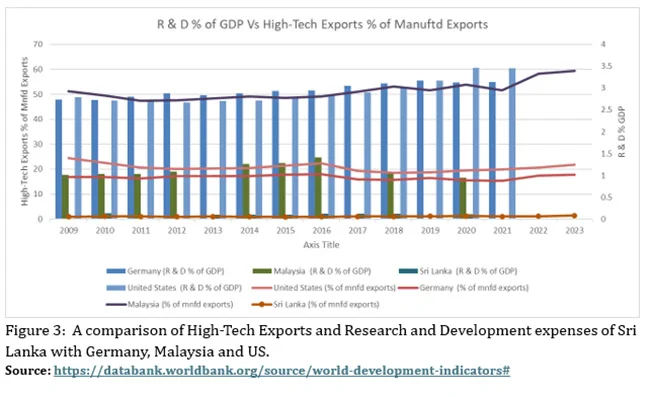
Other Factors Influencing High-Tech Exports
While R&D is the primary driver of high-tech exports, several other factors also influence a country’s ability to compete in global technology markets. These include:
* Infrastructure and Logistics:
Efficient infrastructure, including transportation networks, digital connectivity, and advanced manufacturing facilities, is crucial for exporting high-tech products. However, without strong R&D, infrastructure alone cannot drive technological advancements.
* Trade Policies and Regulations:
Favourable trade policies, such as low tariffs, export incentives, and intellectual property protections, facilitate high-tech exports. Yet, without continuous innovation from R&D, trade policies alone cannot sustain competitiveness.
* Human Capital and Skilled Workforce:
A highly educated and technically skilled workforce is essential for high-tech industries. While talent is important, it must be complemented by R&D investments to create and commercialize innovations.
* Foreign Direct Investment (FDI):
FDI brings capital, expertise, and market access, enhancing a country’s ability to export high-tech products. However, nations that do not invest in R&D risk becoming mere assembly hubs rather than innovation leaders.
* Access to Capital and Financial Support:
Access to venture capital, government funding, and financial incentives supports high-tech industries. Yet, financial resources alone do not guarantee technological progress without active R&D efforts.
Why R&D is the Most Powerful Factor
Despite the influence of these factors, R&D remains the most powerful driver of high-tech exports because it is the source of continuous innovation and competitive advantage. Infrastructure, policies, human capital, and financial support can facilitate high-tech exports, but without groundbreaking research and new technological developments, a country risks stagnation in global markets. Nations that lead in high-tech exports—such as the US, Japan, and China—have consistently prioritized R&D, enabling them to pioneer new technologies and set industry standards.
Enhancing International Competitiveness
A strong R&D culture equips businesses with the ability to maintain a competitive edge in global markets. By developing proprietary technologies and advanced manufacturing processes, firms can reduce production costs, improve product functionality, and increase overall efficiency. This, in turn, enhances their competitive standing in international markets, allowing them to secure long-term trade relationships. Additionally, R&D-driven innovation fosters brand reputation and consumer trust, leading to increased demand for high-tech exports.
Economic Sustainability and Knowledge-Based Growth
Investing in R&D facilitates long-term economic sustainability by transitioning economies from resource-based models to knowledge-driven ones. High-tech exports contribute significantly to GDP growth, employment generation, and foreign exchange earnings. Countries that prioritize R&D in their high-tech sectors experience increased productivity, reduced dependency on traditional industries, and higher value-added output. Moreover, R&D fosters entrepreneurship and the development of start-ups, further strengthening the high-tech export ecosystem.
The Role of Government Policies and Industry Collaboration
Governments play a crucial role in fostering R&D through policy frameworks, financial incentives, and strategic collaborations. Public-private partnerships, tax incentives, and funding for research institutions are essential mechanisms that stimulate innovation. Additionally, collaboration between universities and industries facilitates technology transfer and the commercialization of research outcomes, leading to the development of exportable high-tech products.
The most appropriate and suitable types of R&D for driving high-tech exports include:
1. Applied Research
Applied research is crucial for fostering high-tech exports as it focuses on developing new technologies with immediate commercial applications. Unlike basic research, which is theoretical in nature, applied research is directed toward practical outcomes that enhance global competitiveness. For example, advancements in nanotechnology and artificial intelligence (AI) have significantly contributed to the global expansion of semiconductor and automation industries. Furthermore, applied research helps in bridging the gap between scientific discovery and market implementation, ensuring that new technologies can be effectively utilized in high-tech exports.
2. Product Development R&D
Product development R&D plays a key role in creating innovative products with unique features, enabling firms to differentiate themselves in international markets. It involves activities, such as prototype testing, performance enhancement, and feature innovation, which contribute to the competitive advantage of high-tech firms. For instance, the global smartphone industry continuously invests in R&D to develop new functionalities, improve user experience, and introduce cutting-edge designs, thereby sustaining consumer demand in highly competitive markets. The strategic focus on product innovation allows firms to maintain premium pricing and brand loyalty in high-tech sectors.
3. Process Innovation R&D
Process innovation R&D enhances production efficiency and cost-effectiveness, making high-tech exports more competitive in price-sensitive markets. This type of R&D focuses on improving manufacturing techniques, reducing waste, and integrating automation to optimize resource utilization. For example, the use of additive manufacturing (3D printing) in aerospace and biomedical industries has resulted in cost reductions and faster production cycles, leading to improved market penetration of high-tech exports. Companies that invest in process innovation are able to achieve economies of scale and maintain long-term cost advantages in global markets.
4. Collaborative R&D
Collaborative R&D, involving partnerships between academia, industry, and government, accelerates the commercialization of new technologies. Public-private partnerships (PPPs) facilitate knowledge exchange, reduce R&D costs, and increase the likelihood of successful innovation. A notable example is the European Union’s Horizon 2020 programme, which funds cross-border collaborative research to enhance industrial competitiveness and technological leadership. Additionally, collaboration between multinational corporations and research institutions has led to breakthrough innovations in biotechnology, renewable energy, and telecommunications. By leveraging diverse expertise and shared resources, collaborative R&D enhances the scalability and global reach of high-tech exports.
5. Market-Driven R&D
Market-driven R&D aligns research efforts with global consumer trends and regulatory requirements to maximize export potential. Unlike traditional R&D approaches that focus solely on technological advancements, market-driven R&D emphasizes consumer needs, sustainability, and compliance with international standards. For example, the increasing demand for environmentally friendly products has prompted R&D investments in electric vehicles (EVs) and sustainable packaging solutions, ensuring market acceptance and regulatory approval in various regions. Companies that integrate market intelligence into their R&D strategies are better positioned to develop products that meet international demand, enhance brand reputation, and drive high-tech export growth.
Conclusion
R&D stands as a cornerstone in driving high-tech exports, shaping a nation’s ability to compete in the global economy. While factors such as infrastructure, trade policies, human capital, FDI, and financial support play a role in high-tech exports, they are secondary to the fundamental necessity of continuous innovation. By fostering technological advancements, enhancing competitiveness, and promoting economic sustainability, R&D investments serve as the ultimate catalyst for high-tech export growth. Countries aiming to strengthen their high-tech export sectors must prioritize R&D policies and create an ecosystem that supports innovation, ensuring long-term prosperity in an increasingly technology-driven world.
Investing in different types of R&D is essential for fostering high-tech exports. Applied research drives technological advancements, product development R&D ensures market differentiation, and process innovation R&D enhances cost efficiency. Additionally, collaborative R&D accelerates innovation through strategic partnerships, while market-driven R&D ensures alignment with global consumer trends and regulatory standards. A comprehensive approach that incorporates all these R&D types will enable firms to sustain their competitive advantage and expand their presence in the global high-tech market.
(The writer, a senior Chartered Accountant and professional banker, is Professor at SLIIT University, Malabe. He is also the author of the “Doing Social Research and Publishing Results”, a Springer publication (Singapore), and “Samaja Gaveshakaya (in Sinhala). The views and opinions expressed in this article are solely those of the author and do not necessarily reflect the official policy or position of the institution he works for. He can be contacted at saliya.a@slit.lk and www.researcher.com)
Features
Will NPP continue Sri Lanka’s path of Economic Suicide?

By Sunil Abhayawardhana
Though Sri Lanka has a new government, its first budget for 2025 remains within the conditions and targets of the ongoing IMF programme (which will continue until the end of 2027).
A major shortfall in the budget is the lack of a ‘developmental thrust,’ which is essential for the country to grow out of the current crisis. Rather than discussing the minutiae of the budget, it is worth looking at how Sri Lanka got into this situation by making the same mistakes over and over again.
Though these mistakes can be pointed out, mainstream economists prefer to stick to the outdated textbook economics taught at university even when proven wrong. Therefore, the best way to bring up Sri Lanka’s mistakes is through a comparative approach with the High Performing Asian Economies (HPAEs).
Missed Opportunities
At independence in 1948, Sri Lanka (then Ceylon) was expected to develop rapidly due to advantages such as its strategic location, which was expected to be a multiplier by itself. This ‘strategic location’ has not fully been made use of to this day.
The oil tank farm in Trincomalee was a big storage facility in 1948. If the government had negotiated to buy the facility from the British (which was finally done in 1965 for 250,000 sterling pounds) and set up a refinery, Trincomalee could have become the oil hub of Asia, long before Singapore. This could have saved the country from the perennial forex crisis that it had to deal with due to the diminishing returns from the plantation economy.
The plantation economy had reached its peak over two decades before Independence and was not able to sustain a growing population. Yet, the immediate post-Independence governments did nothing about this. Though funds were available, there was a deficit in the thinking and a lack of vision for the future. The lack of immediate effort to diversify and industrialise the economy was the first act of economic suicide.
At around the same time, HPAEs such as Japan, South Korea, and Taiwan (China) embarked on their development programmes, which have brought results far exceeding their own expectations. What was it that the HPAEs got so right, and what did Sri Lanka get so wrong?
A comparison between Sri Lanka and the HPAEs brings up many differences. The four major points of interest that stand out were as follows:
1) No plan
2) Bad theory
3) Bad advice
4) Not understanding development
No Plan
A sovereign country should know where it wants to go and how it hopes to reach its objectives. This is normally expressed in a development plan that provides the public with a clear roadmap. A plan becomes more necessary when countries start out from a very low level of development. An initial burst of energy is required before markets can take over.
A fair amount of strategic thinking goes into the formulation of such a plan. It should take into account the natural and human resources available and the strategic sectors that need development. The plan should aim to keep the cost of development as low as possible.
In a country with different communities, the plan should also unite people to work towards a common objective. A development plan looks not only at growth but also at the pattern of growth. When growth becomes more widespread, it opens up more opportunities for the public.
All HPAEs began their journeys with development plans covering many decades. Some countries, like China and Vietnam, still adhere to five-year plans. Sri Lanka is the one country that tried to develop without a plan. The World Bank mission of 1952 recommended a planning process for Sri Lanka, though it was hardly implemented. The first Ten-Year Plan of 1959 (which took three years to formulate) was never implemented. The Five-Year Plan of 1972 was derailed by the 1973 oil shock.
While Sri Lanka struggled to plan, the HPAEs were already implementing their plans and seeing results. Sri Lanka drifted to depending on ad-hoc methods without long-term objectives. Even after 77 years of Independence, the country is still unable to identify the sectors for industrial development.
Bad Theory
At independence, the country did not have much know-how in economics. The few who had been educated in economics at the UK universities were taught neoclassical economics with a Keynesian tinge. The Quantity Theory of Money (QTM) was the guiding orthodoxy of the time. What the QTM says is that if the quantity of money is increased, there would be a corresponding increase in prices and therefore inflation.
However, the HPAEs realised that if new money was directed towards investment in productive industry, the result would be an expansion of the economy rather than inflation. The bulk of their funds for development came from monetary financing from the Central Bank. They would have taken inspiration from examples such as Canada in the 1940s and Japan in the 1930s, both of which used monetary financing for specific purposes.
Another point to note is the fact that all the HPAEs had multiple development banks, which helped in the development drive. In contrast, Sri Lanka got rid of its two development banks on advice from the West, thereby reducing the availability of long-term credit for the development process.
Due to Sri Lanka’s adherence to the QTM, we have had to rely on other methods of finance, which has created a dependency on foreign aid and a huge foreign currency debt. Though there is so much evidence that monetary financing used wisely can bring great results, many in Sri Lanka still adhere to the QTM. While most universities still teach the old concepts, it is sad that students at the master’s level and beyond do not think for themselves.
Bad Advice
When a country lacks knowledge and experience, it becomes necessary to seek advice from others. The World Bank and the IMF did perform this function in the early days. However, since the neoliberal onslaught, the purpose of these institutions has taken a more politicised turn.
The advice given by the IMF and other international advice has to be analysed, as it often turns out to be more damaging. For example, austerity has been proven to be counterproductive and causes more damage to the economy and social life. The present advice the government is receiving from the IMF, the CBSL, and the Ministry of Finance is no different.
When South Korean President Park Chung-Hee was offered Western economic advisors, he knew exactly what their advice would be. So, he declined the offer and obtained economic advisors from Japan instead.
Sri Lanka, on the other hand, accepted whatever came from the West. Our leaders accepted the ‘Washington Consensus,’ which we follow to this day, even though the author of the document, John Williamson, has himself declared it a dead document.
Economists advise governments towards suicidal actions without observing what has been done around the world before. There are political aspects to this bad advice. As there is an overproduction of global money, such bad advice is actually beneficial to the Western financial sector and its political interests.
Not Understanding Development
Sri Lanka has still not understood what development means. This can be seen from the fact that despite having a potential 30,000 MW of wind power generation, the government wants to give this opportunity to foreign companies and buy back the power with foreign exchange. Even the export potential is given to foreign companies, while local companies lose that opportunity.
If such a situation had been in any of the HPAEs, they would have first developed a local windmill manufacturing industry to meet their needs. That is what development is – developing productive capabilities and creating a productive ecosystem. There are many opportunities that Sri Lanka has missed because the concept of development has not been understood.
Had local inventors been encouraged and supported, a true industrial base would have been flourishing today. One example is Ray Wijewardene’s hand tractor, to which one Sri Lankan asked, “Why do we need hand tractors when there are so many buffaloes around?”. Imagine what the HPAEs would have done with a brilliant, innovative mind like Ray Wijewardene’s.
Even the few sectors of industry built up to world-class levels have been destroyed by bad government policy. One such industry was the heavy construction industry, which is vital for infrastructure development. A local company had built up its capacity to do international projects funded by the World Bank and had performed many projects in the country, but the change of policy after 1977 destroyed the company and opened the doors to foreign companies at inflated prices, for which the country struggles to pay off its loans.
The local highway construction projects are an example, where Sri Lanka’s highways are considered the most expensive in the world, which opened opportunities for corruption. The very first industry developed in the HPAEs was the heavy construction industry in order to keep the cost of development low. Sri Lanka did the opposite.
Conclusion
It is quite clear that Sri Lanka’s present position is of its own making, following quite the opposite of what the HPAEs did. However, though many learn from mistakes, Sri Lanka does not seem to have learnt any lessons. Our advisors keep telling us to repeat our mistakes, and we keep listening to them.
It was expected that the NPP government would make a radical change in thinking, but it has not expressed any meaningful change of thinking with regard to major issues. Without such a change, Sri Lanka will continue on its suicidal path.
(Sunil Abhayawardhana was CEO of Sri Lanka’s largest heavy construction company. He has a master’s degree from the University of Wales and is working on a PhD in economics. He is a member of the Asia Progress Forum, which is a collective of like-minded intellectuals, professionals, and activists dedicated to building dialogue that promotes Sri Lanka’s sovereignty, development, and leadership in the Global South. APF can be contacted at asiaprogressforum@gmail.com).
Features
Coping with Batalanda’s emergence to centre stage

by Jehan Perera
The Batalanda Commission report which goes into details of what happened during the JVP insurrection of 1987-89 has become the centre of public attention. The controversy has long been a point of contention and a reminder of the country’s troubled past and entrenched divisions that still exist. The events that occurred at Batalanda during the violent suppression of the JVP-led insurgency, remain a raw wound, as seen in the sudden resurfacing of the issue. The scars of violence and war still run deep. At a time when the country is grappling with pressing challenges ranging from economic recovery to social stability, there is a need to keep in focus the broader goal of unity for long-term peace and prosperity. But the ghosts of the past need also to be put to rest without continuing to haunt the present and future.
Grisly accounts of what transpired at Batalanda now fill the social media even in the Tamil media, though Tamils were not specifically targeted at that time. There was then a ceasefire between the government and LTTE. The Indo-Lanka Accord had just been signed and the LTTE were fighting the Indian peacekeeping army. The videos that are now circulating on social media would show the Tamil people that they were not the only ones at the receiving end of counter-terrorist measures. The Sinhalese were in danger then, as it was a rebellion of Sinhalese against the state. Sinhalese youth had to be especially careful.
It appears that former president Ranil Wickremesinghe was caught unprepared by the questions from a team from Al Jazeera television. The answers he gave, in which he downplayed the significance of the Batalanda Commission report have been viewed differently, depending on the perspective of the observer. He has also made a statement in which he has rejected the report. The report, which demands introspection, referred to events that had taken place 37 years earlier. But the ghosts of the past have returned. After the issue has come to the fore, there are many relatives and acquaintances of the victims from different backgrounds who are demanding justice and offering to come forward to give evidence of what they had witnessed. They need closure after so many years.
MORE POLARISATION
The public reaction to the airing of the Al Jazeera television programme is a reminder that atrocities that have taken place cannot be easily buried. The government has tabled the Batalanda Commission report in parliament and hold a two-day debate on it. The two days were to be consecutive but now the government has decided to space them out over two months. There is reason to be concerned about what transpires in the debate. The atrocities that took place during the JVP insurrection involved multiple parties. Batalanda was not the only interrogation site or the only torture chamber. There were many others. Former president Ranil Wickremesinghe was not the only prominent protagonist in the events that transpired at that time.
The atrocities of the late 1980s were not confined to one location, nor were they the responsibility of a single individual or group. The JVP engaged in many atrocities and human rights violations. In addition to members of the former government and military who engaged in counter-terrorism operations there were also other groups that engaged both in self-defence and mayhem. These included members of left political parties who were targeted by the JVP and who formed their own para-military groups. Some of the leaders went on to become ministers in succeeding governments and even represented Sri Lanka at international human rights forums. Even members of the present government will not be able to escape the fallout of the debate over the Batalanda Commission report.
If the debate becomes a battleground for assigning blame rather than seeking solutions, it could have far-reaching consequences for Sri Lanka’s social and political stability. Economic recovery, governance reform, and development require stability and cooperation. The present storm caused by the Batalanda Commission report, and the prospects for increased polarisation and hatred do not bode well for the country. Rather than engaging in potentially divisive debates that could lead to further entrenchment of opposing narratives, Sri Lanka would be better served by a structured and impartial approach to truth-seeking and reconciliation.
NATIONAL HEALING
Earlier this month at the UN Human Rights Council in Geneva, the government rejected the UN High Commissioner for Human Rights assertion that the external evidence gathering unit would continue to collect evidence on human rights violations in Sri Lanka. This evidence gathering unit has a mandate to collect information on a wide range of human rights violations including intimidation and killings of journalists but with a focus on the human rights violations and war crimes during the course of the LTTE war and especially at its end. The government’s position has been that it is determined to deal with human rights challenges including reconciliation through domestic processes.
Addressing the High-Level Segment of the 58th Regular Session of the United Nations Human Rights Council (UNHRC) in Geneva in February this year, Foreign Minister Vijitha Herath said: “The contours of a truth and reconciliation framework, will be further discussed with the broadest possible cross section of stakeholders, before operationalisation to ensure a process that has the trust of all Sri Lankans. Our aim is to make the domestic mechanisms credible and sound within the constitutional framework. This will include strengthening the work towards a truth and reconciliation commission empowered to investigate acts of violence caused by racism and religious extremism that give rise to tensions within Sri Lankan society.”
The concept of a truth and reconciliation commission was first broached in 2015 by then prime minister Ranil Wickremesinghe’s government. In 2019 after winning the presidential elections, former president Gotabaya Rajapaksa too saw merit in the idea, but neither of these two leaders had the commitment to ensure that the process was completed. Promoting reconciliation in Sri Lanka among divergent political actors with violent political pasts requires a multi-faceted approach that blends political, social, and psychological strategies.
Given the country’s complex history of armed conflict, ethnic tensions, and political polarisation, the process must be carefully designed to build trust, address grievances, and create a shared vision for the future. A truth and reconciliation process as outlined in Geneva by the government, which has teeth in it for both punishment and amnesty, can give the country the time and space in which to uncover the painful truths and the path to national healing.
-

 Foreign News4 days ago
Foreign News4 days agoSearch continues in Dominican Republic for missing student Sudiksha Konanki
-
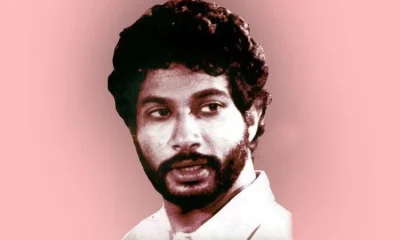
 Features7 days ago
Features7 days agoRichard de Zoysa at 67
-

 Features4 days ago
Features4 days agoThe Royal-Thomian and its Timeless Charm
-
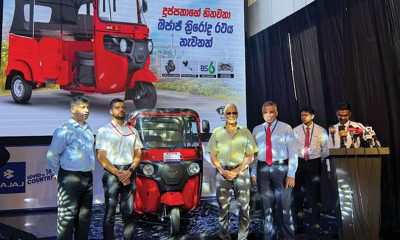
 News5 days ago
News5 days agoDPMC unveils brand-new Bajaj three-wheeler
-
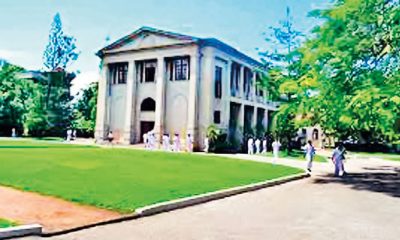
 Features4 days ago
Features4 days ago‘Thomia’: Richard Simon’s Masterpiece
-

 Sports2 days ago
Sports2 days agoSri Lanka to compete against USA, Jamaica in relay finals
-
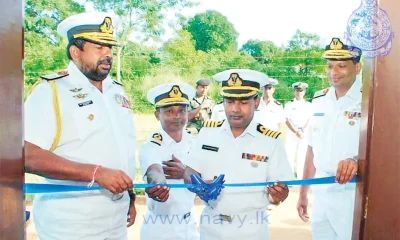
 Features7 days ago
Features7 days agoSL Navy helping save kidneys
-
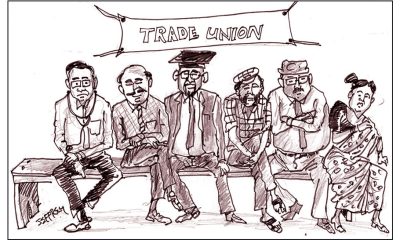
 Features6 days ago
Features6 days agoWomen’s struggles and men’s unions











